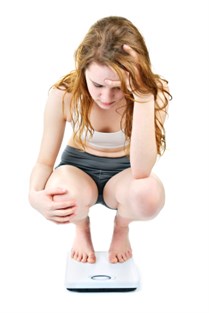 Do You…
Do You…
Weigh yourself multiple times a day?
Skip at least one meal a day?
Count calories and fat grams every time you eat?
Exercise “a lot” because you have to and not because you want to?
Eating disorders, such as anorexia, bulimia, and binge eating disorder are characterized by extreme emotions, attitudes, and behaviors surrounding weight and food. Eating disorders involve serious emotional and physical problems that can have life-threatening consequences for all genders.
ANOREXIA is characterized by self-starvation and excessive weight loss.
Symptoms include:
BULIMIA is characterized by a cycle of binge eating followed by purging. Bulimia includes eating large amounts of food in a short period of time (more than most people would eat in one meal), then getting rid of the food and calories through vomiting, laxative use, over-exercising, or other means.
Symptoms include:
People who have bulimia often do not appear underweight, but they do often exhibit other signs of an eating disorder. Recovery for bulimia is often most effective the earlier a person seeks treatment…so it is important that everyone is aware of the warning signs.
Warning Signs:
Potential Health Consequences:
BINGE EATING DISORDER is characterized by periods of uncontrolled, impulsive or continuous eating beyond the point of feeling comfortably full. While there is no purging, there may be sporadic fasts or repetitive diets and often feelings of shame or self-hatred.
Symptoms:
Potential Health Consequences:
OTHER EATING DISORDERS can include some combination of the signs and symptoms of anorexia, bulimia and/or binge eating. These behaviors are harmful and negatively impact daily life.
Disordered Eating
Disordered eating describes irregular patterns of eating and it occurs when an individual has an unhealthy relationship with food. These eating habits may eventually result in psychological and/or physical harm, yet do not meet the criteria of an eating disorder.
Examples of Disordered Eating:
Getting Help
All eating disorders require professional help. If you would like to speak to a counselor about your situation or need a referral for treatment, please contact the USI Counseling Center at 812-464-1867.
Online Resources
Counseling and Psychological Services (CAPS) is a SAFE ZONE for individuals of all ethnicities, abilities, religions, sexual orientations, physical appearances/sizes, and gender identities.
Contact Information
Location: OC 1051
Phone: 812-464-1867
Email: usi.caps@usi.edu
Hours: M - F, 8am - 4:30pm
Request an Appointment
Click here to request an appointment. After your request is submitted, we will contact you to schedule an appointment.
Peer Support for Students
Find Us on Social Media